Introduction:
Concrete is a building material made of cement, aggregates (rock and sand), water, and additives (chemicals that enhance or modify the properties of concrete). There are a lot of chemicals used in construction now. From concrete admixtures to sealants, grouts, bonding agents, and waterproofing chemicals, the construction chemicals industry has a wide range of products. The construction industry uses these chemicals in a lot of different ways. These construction chemicals can make concrete stronger, and when used in different ways and amounts, they can also help get around many other problems. One chemical that is used in concrete is a “bonding agent.” This article will discuss concrete bonding agents and different types of concrete bonding agents.
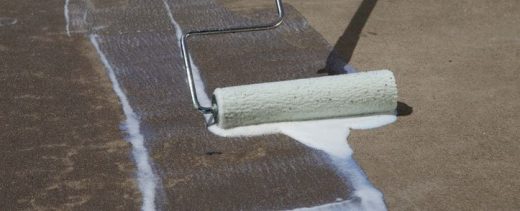
Fig 1: Concrete Bonding Agent
Courtesy: decorativeconcreteresurfacing.com
What is Concrete Bonding Agent?
Concrete bonding agents are natural or man-made materials that join old and new concrete surfaces. This agent can also be used to join the concrete layers. This bonding agent helps the different concrete finishes act like a single unit. These cement bonding agents are also used to make repairs, like joining new concrete to old concrete, spraying concrete at construction joints, or using cement-sand repair mortar to make a strong bond.
Importance of Concrete Bonding Agent:
Most of the times, bonding agents are used in concrete when the old and new concrete surfaces need to be joined. It is also used to connect the surfaces of the concrete layers that go on top of each other. The main job of a bonding agent is to make the bond between the old and new concrete surface stronger. The cement in a concrete mix doesn’t have anything that naturally makes it stick together. So, when new concrete is poured over an existing layer, the two layers don’t tend to stick together. Once the first layer of concrete has hardened, the new layer will sit on top as a separate layer. It won’t make a strong bond between the two layers that come after it.
So, when the two layers don’t work as a single unit, the performance and strength of the structure will suffer. So, a bonding agent (also called a bonding adhesive) must be put on the existing concrete surface so that the new concrete will stick. It is also true for fixing floors. If concrete without any bonding agent is used to fill gaps produced by deterioration, the new concrete will not stick to the old concrete without the help of bonding glue.
Features of Concrete Bonding Agent:
- It has high adhesive strength and is easy to manipulate.
- Strengthens concrete and mortar in tensile, flexural, and bonding directions.
- Thirdly, it lessens the concrete’s permeability.
- This factor lessens the potential for cracking.
- As a result, it improves the material’s resistance to cold and other chemicals.
- It facilitates straightforward implementation and utilization.
Functions of Concrete Bonding Agent:
Cement in a concrete mixture does not contain any bonding agent. The two will not bond if new concrete is placed on top of an older layer. That’s why it’s important to have some bonding agent in there. Adding a bonding chemical between concrete layers makes them function like one solid slab, improving the building’s durability and efficiency. Applying a bonding agent to the concrete’s surface ensures that newly placed concrete will attach to the existing slab.
Some factors impact how well the old and new concrete bond. There are mainly two things that affect how well the old and new concrete stick together:
- The strength and integrity of the old surface
- Cleanness of the old surface.
How to Use Concrete Bonding Agent?
The following procedure should be used for applying the bonding agent:
- First, the concrete surface that is already there is cleaned. For the bonding agent to work well, all dirt, dust, oil, and efflorescence must be completely cleaned off the surface. Pressure washing or vacuum shot blasting can clean concrete surfaces with too much dirt.
- After the surface of the concrete has been cleaned, the admixture is made. Before it is used, the chemical is shaken. It is mixed well, and water is used to dilute it. It is always best to read the manufacturer’s instructions to ensure you know how to use the product.
- The next step is to mix the mixture in the right way. Once the chemical is mixed with water, the manufacturer’s instructions will tell you how long you must use the mixture.
- The first bonding agent layer is placed on the surface, and the fresh concrete mix is placed on top. Before the first coat starts to dry, the concreting must be done.
- After the concrete layer is put down, it is smoothed out with a trowel and left to dry.
Types of Concrete Bonding Agent:
1. Epoxy Resin:
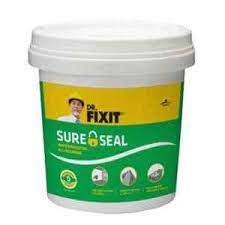
Fig 2: Epoxy Resin
Courtesy: moglix.com
Epoxy resin is a concrete bonding agent widely used in construction because it is strong, doesn’t react with chemicals, and sticks well. Epoxy resin can bond to a wide range of materials as long as the surface is clean and ready. It can also be used to glue things together quickly. Some of the factors that make epoxy resin good at holding things together are:
- When epoxy resins harden, they are stronger in tension and compression than concrete.
- Compounds made of epoxy resin don’t have any volatile solvents. After curing, all of the liquid resin turns into solids.
- Epoxy resin can stick to just about any building material.
- During the time it takes for epoxy resins to harden, they don’t make any waste.
- There aren’t many cracks caused by shrinkage during or after curing.
- Once cured, epoxies don’t change in size.
2. Acrylic Latex:
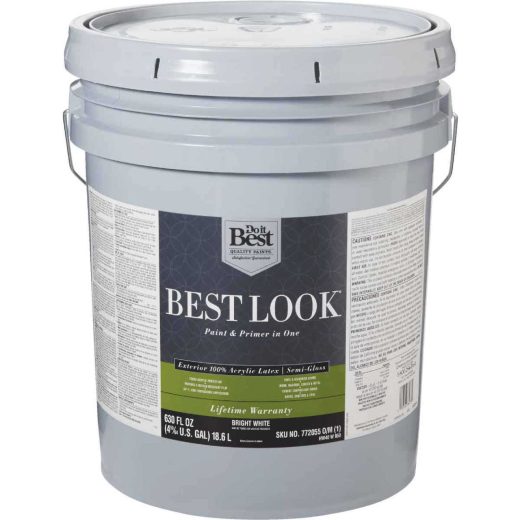
Fig 3: Acrylic Latex
Courtesy: doitbest.com
Polymers and co-polymers of methacrylic acid and acrylic esters are called acrylic esters. Depending on the polymers used, the physical properties of acrylic latex range from soft elastomers to hard plastics. Acrylic latex is milky white and has 45% solid content. This type of latex is mostly used to connect new concrete to old concrete. It can be used as an adhesive with a brush, broom, spray, roller, or trowel or as a topping with a trowel. This emulsion is used similarly to SBR Latex in cementitious compounds.
3. Latex Emulsions:
Latex emulsions are often used as oil-in-water type emulsions in cementitious mixtures. There are three types of latex emulsions, and some of them have more than 50% water in them. Some glue can also stand up to water better than others. Latex emulsions don’t change when mixed with water and cement, but not all emulsions can be mixed with cement. So, to choose the right latex emulsion for your work, you need to know how it works from a chemical point of view.
If you use the latex emulsion agent without cement in the concrete mix, there won’t be a film at the bond interface, so the concrete will crack. Latex emulsions can be converted into functional bonding agents in the following ways:
- Add some latex to the water used to make cement slurry and mix until it reaches the desired consistency.
- Dilute the latex emulsion by mixing it with water at 1 to 1.
- Use re-emulsifiable latex, which becomes pliable again when exposed to water.
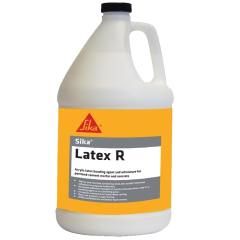
Fig 4: Latex Emulsions
Courtesy: civiconcepts.com
4. Styrene Butadiene Latex:
Latex made from styrene-butadiene (SBR) is a co-polymer used safely alongside cement. Nonetheless, Styrene butadiene latex can coagulate if heated for too long at too high a temperature. Styrene butadiene latex, like acrylic latex, is a milky white color and can have a solid percentage of up to 55%. They are useful for adhering new concrete to preexisting slabs or sealing thin tops. Also, they can be used as a plaster bond in 45-60 minutes. The uses of styrene butadiene latex are as follows:
- It can be used with cement to create a waterproof barrier on roof slabs, hollow slabs, basements, water tanks, sunshades, etc.
- It also can be used in the production of polymer mortar for use in construction, maintenance, etc./
- It’s a bonding agent; therefore, it can be used for patching and plastering.
- It is used for leaching and saltpeter action treatment
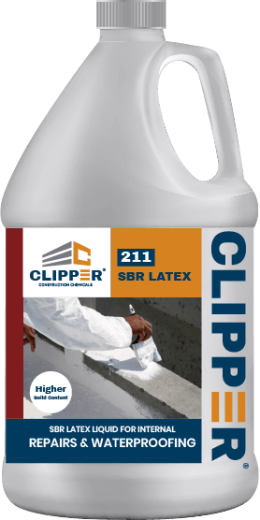
Fig 4: Styrene Butadiene Latex
Courtesy: civiconcepts.com
5. Polyvinyl Acetate Latex:
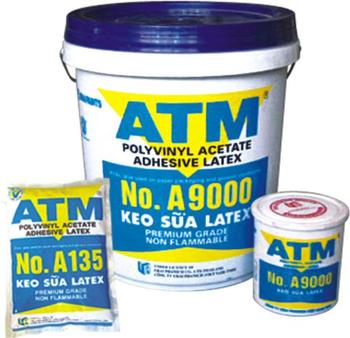
Fig 4: Polyvinyl Acetate Latex
Courtesy: ypkhmer.com
Most of the time, this agent is used to fix concrete. Polyvinyl acetate latex is good at not getting wet, damaged by UV light, and not getting old. It has become more popular because it works well with cement.
Polyvinyl acetate latex comes in two main varieties, both of which find use in various construction repair applications. They can be emulsified but not re-emulsified. A thin film is formed by the non-re-emulsifiable, and it has excellent water resistance, aging properties, and ultraviolet stability. This latex is commonly used as a bonding agent since it works well with cement. At the same time, emulsifiable polyvinyl acetate latex creates a film that can be rewetted and re-softened with water. This latex allows the film to be applied before the water-based topcoat is applied.
Conclusion:
When a concrete floor is damaged, you can either destroy and rebuild or resurface the area. Costs more and takes more time is replacing old concrete with new concrete. The most practical approach is to apply a new layer of concrete over top of the old one. Even so, the fresh concrete will eventually settle on top of the old surface, creating a new layer. Initially, you should apply the concrete bonding agent to the broken area. With proper adhesion, the new concrete layer will become integral to the existing one. For the concrete to perform uniformly and without defects under its weight, a bonding agent must be added to the concrete’s existing surface.
References:
1. Prasad. “Concrete Bonding Agents – Structural Guide.” Structural Guide, 10 Nov. 2020, www.structuralguide.com/concrete-bonding-agents.
2. BuilderSpace. “What Is the Best Concrete Bonding Agent? – BuilderSpace.” BuilderSpace, 16 Sept. 2020, www.builderspace.com/what-is-the-best-concrete-bonding-agent.
3. “The Best Concrete Bonding Agents for Your Project.” Bob Vila, 29 Dec. 2020, www.bobvila.com/articles/best-concrete-bonding-agent.
4. Sakrete, and More about Sakrete » “Concrete Bonding.” Instructables, www.instructables.com/Concrete-Bonding. Accessed 27 Dec. 2022.
5. “Concrete Bonding Agent: Types, Characteristics and Procedure to Apply!” Concrete Bonding Agent: Types, Characteristics & Procedure to Apply!, 20 Dec. 2017, gharpedia.com/blog/bonding-agent-for-concrete-and-types.
6. admin. “Concrete Bonding Agents: Why You Need Them, How to Choose.” Concrete Bonding Agents: Why You Need Them, How to Choose, 22 Sept. 2015, www.rocland.eu/en/concrete-bonding-agents-why-you-need-them-and-which-to-choose.
If you have a query, you can ask a question here.



hello mr. singh
i am bonding some new cement to old cement in my basement–i have a water sealer that i used on some new porch steps…can i mix or use this sealer(its milk white), as a bonding agent for a small framed concrete post slab 4″ l x 4″w x 4″ d?
thank you for your info
Al